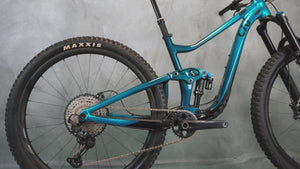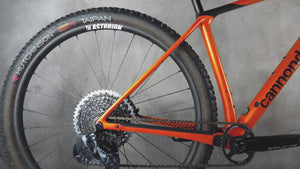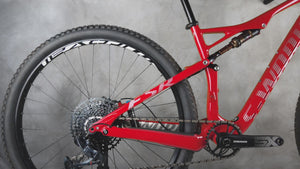Carbon Vs. Aluminum: Which one to choose?
In this Article
Posted on February 28, 2022
When it comes to choosing your future bike, one of the main questions we all ask is that of the frame material. The budget is often one of the determining factors but we will see that it is far from being the only one. The real question is what material is better suited to the use you plan to make of it?
When you think bike, the first image that comes to mind is the frame, it is the very structure of the machine of our dreams. Most of the frames are today made of aluminum or carbon fiber. We will see their main differences here to help you compare and decide.
Let's start with the basics. First of all, all carbon frames are not created equal.
Carbon, one of the most optimable materials, is used in some of the best bikes, in Formula 1 and in planes. It is light, rigid, and elastic. The problem is that not all carbon is equal and that the simple fact that they have a name does not guarantee that they are better than other materials for frames, such as aluminum.

The choice between aluminum and carbon is not so simple. The low -end bikes made with carbon frames are not necessarily better than those in aluminum. Low -end carbon frames have unwanted characteristics, such as a feeling of wood and lack of elasticity. Do not start from the principle that a bike is better because its description contains the word carbon.
In summary, entry-level road bikes with a carbon frame may be affordable, but in most cases, recent aluminum alloy bikes are a better option at a comparable price.
Hardness and sensation to driving?
Conventional wisdom in cycling is that aluminum is rigid and hard, while carbon is flexible and soft. However, this received idea is widely exceeded. It was true 20 years ago, when aluminum frames were not optimized.
The sensation on the road has long been the claimed advantage of carbon frames. Carbon can be designed to be rigid in certain directions and flexible in others. This means that a carbon frame can be comfortable on the bumps and rugged roads while being effective in pedaling. However, improving technology has reduced the comfort gap between aluminum and carbon over the past two decades.
Modern bikes, whether in carbon or aluminum, are surprisingly rigid and reactive, without being too hard. When you apply a significant effort on the pedals or plunge into a turn, a well -designed setting needs rigidity to resist the torsion forces. These same constraints will deprive you of power and responsiveness, so it is really a fine balance.
Is a material more efficient than another? Technically, carbon is supposed to be superior. Manufacturers use different forms of tubes and different thicknesses for aluminum frames to control the driving characteristics. But fundamentally, carbon fiber offers more possibilities to engineers to settle the quality of driving. Just modify the composition of the carbon (the direction in which the carbon fibers are oriented) to obtain rigidity in a specific direction and in a particular area.

But manufacturers can now vary the shape of aluminum tubes, making them finer - sometimes as light than a soda can - in areas where flexibility is desired and thicker where rigidity and resistance are necessary. This means that a modern aluminum frame is not significantly less comfortable on ordinary roads than its carbon counterparts.
It is extremely difficult to objectively quantify the difference in comfort between two similar bikes. However, the design of the bicycle has a considerable influence on comfort. Like tires, contact points with the cyclist and other components.
In summary, carbon has a slight advantage, but if comfort is your main concern, the frame material is secondary compared to other larger factors. So start by asking yourself the question: is the bike intended for road race or endurance? Then examine elements such as wheels, tires width, position or geometry. Finally, comfort can be constantly adjusted or improved, regardless of the frame material.
Is carbon lighter?
When we talk about bikes, we talk about weight. This is one of the most important considerations when buying a new bike. It is possible to build very light and efficient aluminum or carbon bikes. However, a carbon frame will be almost always lighter than an equivalent aluminum frame. Many manufacturers now produce carbon road bikes that weigh less than 7kg and cross-country mountain bikes that weigh approximately 9kg. For record fans, the framework of Specialized S-Works Aethos Weighs only 588g (size 56)!

But as we have explained, not all carbon is equal. A low -end carbon frame can weigh heavier than a high -end aluminum frame.
Are aluminum bikes more durable?
Many cyclists are afraid of damaging an expensive carbon frame. However, the resistance/weight ratio of carbon fiber is higher than that of steel, and carbon frames can survive very extreme conditions. Its fatigue lifespan is also almost infinite and, under perfect conditions, long -term use will not "use" it.
The most important risk for carbon frames are cracks and damage by direct impact, as is the case during a large collision. Fortunately, carbon can be easily repaired and, when done correctly, the performance and sustainability of the fixed frame is identical to those of a new frame. Unfortunately, the same cannot be said about aluminum.
If aluminum frames cannot generally be repaired, they are less expensive to replace. Aluminum can also withstand certain shocks and impacts and be still usable.
It is important to note that the care you take to your bike, both during its use and when storage, is essential to its longevity. It is interesting to note that the frame of a bicycle is generally damaged only in a few cases: 1. During a fall, or 2. during transport. This is undoubtedly a subject for another day, but the way you transport your equipment is essential. Please pay particular attention to the way you carry and store your bike when not used.
Are aluminum bikes cheaper than carbon bikes?
There is no real discussion on this subject. Carbon is more expensive. It takes more engineering, the manufacturing process requires more work and each frame requires a specific mold, which increases the cost even more. At equal prices, an aluminum bike will generally have more beautiful components than a carbon bicycle. It is a question of finding the happy medium between paying for the quality of the frame and that of the components. Remember that the components are always easier to improve than the whole frame.
In the end, the choice of frame is above all a vs cost decision. other advantages. Professional runners are ready to pay the high price to obtain marginal advantages in terms of performance, maneuverability, comfort and sustainability. On the other hand, it is sometimes preferable to buy the best possible specifications at a given price rather than being seduced by exotic materials like carbon.
And the look?
Carbon fiber has opened new possibilities in the design of bicycles. The sweet curves and rounded shapes of today's bikes were unimaginable during the era of steel and titanium.

But the manufacture of aluminum bikes has also become efficient enough to produce bikes that resemble their carbon counterparts. Weld -free junctions can add to this smooth appearance, making certain new aluminum frames almost indistinguishable from carbon remotely.

For some, welds can also be a brand of beauty. Perfect, clean and regular welds represent an excellent craft work. But, on the other hand, thick and robust welds can give a bike an impression of robustness and preparation for difficult driving for mountain bike lovers.
In the end, any material can make a beautiful bike if it is well done. This question depends on the cyclist, and if you are satisfied, that's all that matters.
Conclusion
Based on this information, ask yourself questions when you choose a new bike. What is your budget ? Are you a more occasional competition cyclist or cyclist? How important is the weight? Do you plan to transport the bike often (does this increase the risk of impact)? Some cyclists do not need carbon. Others do not support the idea of rolling in aluminum.
We have given you the information, now it's up to you to decide. Remember that the most important factor in choosing a bicycle is you. What makes you happy will give you happy outings!






































2 comments
Yo he tenido bicis de aluminio, de carbono y hace años incluso de acero. Es verdad que los tiempos han cambiado mucho y las bicis de ahora poco tienen que ver con las de hace 20 años. Ahora bien, después de haber probado esos tres materiales me quedo indudablemente con el carbono. Hablo de bicis de carretera, la ligereza y reactividad que proporciona el carbono está lejos de lo que puede dar de si el aluminio, a no ser que te compres una aluminio de tope de gama en cuyo caso el coste económico pone en entredicho la ventaja del aluminio.
El único temor del carbono es tener una caída y dejar el cuadro hecho un jiñapo. Sacando eso, las sensaciones y la diversión que proporciona el carbono para mí no tienen rival. Lo demás ya es cuestión de lo que uno se pueda permitir. Pero incluso hoy en día en el mercado de segunda mano puedes comprar una bici de carbono a mejor precio que una de aluminio, hay auténticos chollos.
Bravo article riche et complet. J ai deja un carbone mais j ai conseillé à un ami de prendre alu avec de bons equipements, la difference lui paiera de bonnes jantes carbones.